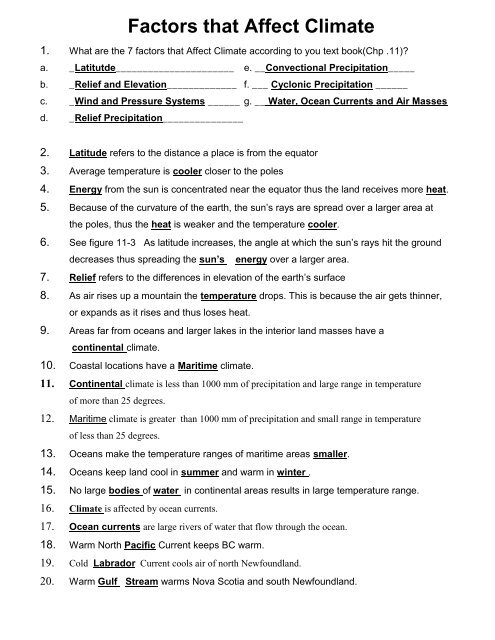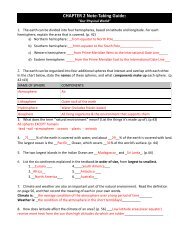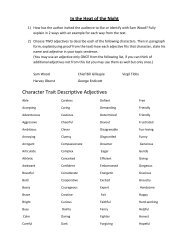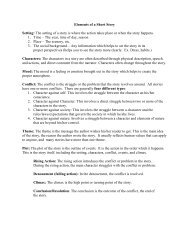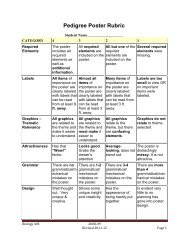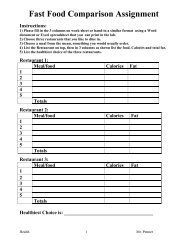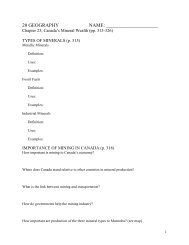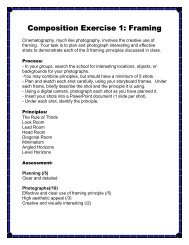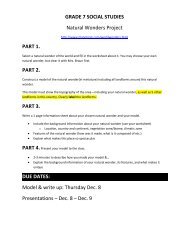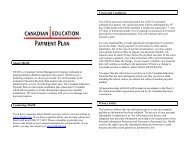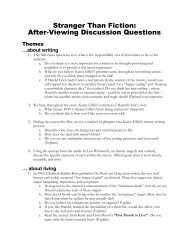Factors that Affect Climate - schs
Factors that Affect Climate - schs
Factors that Affect Climate - schs
Create successful ePaper yourself
Turn your PDF publications into a flip-book with our unique Google optimized e-Paper software.
<strong>Factors</strong> <strong>that</strong> <strong>Affect</strong> <strong>Climate</strong><br />
1. What are the 7 factors <strong>that</strong> <strong>Affect</strong> <strong>Climate</strong> according to you text book(Chp .11)?<br />
a. _Latitutde______________________ e. __Convectional Precipitation_____<br />
b. _Relief and Elevation_____________ f. ___ Cyclonic Precipitation ______<br />
c. _Wind and Pressure Systems ______ g. __ Water, Ocean Currents and Air Masses<br />
d. _Relief Precipitation_______________<br />
2. Latitude refers to the distance a place is from the equator<br />
3. Average temperature is cooler closer to the poles<br />
4. Energy from the sun is concentrated near the equator thus the land receives more heat.<br />
5. Because of the curvature of the earth, the sun’s rays are spread over a larger area at<br />
the poles, thus the heat is weaker and the temperature cooler.<br />
6. See figure 11-3 As latitude increases, the angle at which the sun’s rays hit the ground<br />
decreases thus spreading the sun’s energy over a larger area.<br />
7. Relief refers to the differences in elevation of the earth’s surface<br />
8. As air rises up a mountain the temperature drops. This is because the air gets thinner,<br />
or expands as it rises and thus loses heat.<br />
9. Areas far from oceans and larger lakes in the interior land masses have a<br />
continental climate.<br />
10. Coastal locations have a Maritime climate.<br />
11. Continental climate is less than 1000 mm of precipitation and large range in temperature<br />
of more than 25 degrees.<br />
12. Maritime climate is greater than 1000 mm of precipitation and small range in temperature<br />
of less than 25 degrees.<br />
13. Oceans make the temperature ranges of maritime areas smaller.<br />
14. Oceans keep land cool in summer and warm in winter .<br />
15. No large bodies of water in continental areas results in large temperature range.<br />
16. <strong>Climate</strong> is affected by ocean currents.<br />
17. Ocean currents are large rivers of water <strong>that</strong> flow through the ocean.<br />
18. Warm North Pacific Current keeps BC warm.<br />
19. Cold Labrador Current cools air of north Newfoundland.<br />
20. Warm Gulf Stream warms Nova Scotia and south Newfoundland.
<strong>Factors</strong> <strong>that</strong> <strong>Affect</strong> <strong>Climate</strong><br />
21. When warm and south currents meet at Grand Banks, it is damp and foggy .<br />
22. See Figure 11-7. Draw and Label the 5 ocean currents, include whether it is cold or<br />
hot. Draw and Label the air masses, include moisture content and temperature.<br />
23. An air mass is a large, stable volume of air. It has the same climate conditions<br />
of the area over which it was formed.<br />
24. When the air mass moves it brings <strong>that</strong> climate with it.<br />
25. As the air passes over land, the moisture is released in some form of precipitation.<br />
26. Air, like everything on Earth, has weight, which is called air pressure.<br />
27. When air moves from high pressure areas to low pressure areas this is called wind.<br />
28. There are high and low pressure belts <strong>that</strong> have created a well established<br />
pattern of prevailing winds.<br />
29. In North America, cold, dry arctic moves southward and warm moist gulf air moves northward.<br />
30. When two air masses meet it is called a front.<br />
31. High in the atmosphere above the polar front is a current of fast-moving air called<br />
the polar front jet stream.<br />
32. Precipitation occurs when air cools as it rises and as air cools, water vapour<br />
condenses more than it evaporates.<br />
33. Mountain barriers create relief precipitation.<br />
34. As moist air rises up the windward slope it expands and cools.
<strong>Factors</strong> <strong>that</strong> <strong>Affect</strong> <strong>Climate</strong><br />
35. Rising air cools and expands, thus condensing the water droplets causing clouds.<br />
36. When the clouds get to heavy they release the droplets as rain.<br />
37. Precipitation can take form of rain, snow, sleet, frost or dew.<br />
38. Precipitation happens on the windward side of the mountain.<br />
39. As cool air descends on the more protected leeward slope of the mountain range,<br />
it contracts and becomes warmer.<br />
40. Leeward sides of mountains are dryer.<br />
41. Convectional precipitation is very common in summer in continental locations,<br />
such as Prairie provinces.<br />
42. The rising air expands and cools, and the water vapour within it condenses to<br />
form puffy white clouds.<br />
43. The clouds develop vertically throughout the day as more and more moisture<br />
condenses and the water droplets get _larger and larger.<br />
44. As the water droplets fall to the ground, the raindrops cools the air and<br />
drag some of it downward, creating downdrafts_.<br />
45. Air masses <strong>that</strong> are different in moisture content and temperature do not mix easily.<br />
46. Cyclonic storms are a large, low-pressure systems <strong>that</strong> forms when warm air mass<br />
and cold air masses collide; a front develops.<br />
47. As the warm air mass moves inward toward the centre of low pressure, it rises<br />
and cools creating precipitation.<br />
48. In North America, these low pressure storm systems move from west to east<br />
throughout the year.<br />
49. Most of the precipitation in the Prairies, especially in winter, is cyclonic.


